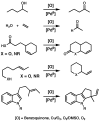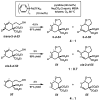Oxidative cyclizations in a nonpolar solvent using molecular oxygen and studies on the stereochemistry of oxypalladation
- PMID: 16351107
- PMCID: PMC2585987
- DOI: 10.1021/ja055534k
Oxidative cyclizations in a nonpolar solvent using molecular oxygen and studies on the stereochemistry of oxypalladation
Abstract
Oxidative cyclizations of a variety of heteroatom nucleophiles onto unactivated olefins are catalyzed by palladium(II) and pyridine in the presence of molecular oxygen as the sole stoichiometric oxidant in a nonpolar solvent (toluene). Reactivity studies of a number of N-ligated palladium complexes show that chelating ligands slow the reaction. Nearly identical conditions are applicable to five different types of nucleophiles: phenols, primary alcohols, carboxylic acids, a vinylogous acid, and amides. Electron-rich phenols are excellent substrates, and multiple olefin substitution patterns are tolerated. Primary alcohols undergo oxidative cyclization without significant oxidation to the aldehyde, a fact that illustrates the range of reactivity available from various Pd(II) salts under differing conditions. Alcohols can form both fused and spirocyclic ring systems, depending on the position of the olefin relative to the tethered alcohol; the same is true of the acid derivatives. The racemic conditions served as a platform for the development of an enantioselective reaction. Experiments with stereospecifically deuterated primary alcohol substrates rule out a "Wacker-type" mechanism involving anti oxypalladation and suggest that the reaction proceeds by syn oxypalladation for both mono- and bidentate ligands. In contrast, cyclizations of deuterium-labeled carboxylic acid substrates undergo anti oxypalladation.
Figures








Similar articles
-
Stereochemistry and mechanistic study of intramolecular Pd(II)-catalyzed oxypalladation and 1,3-chirality-transfer reactions.Chem Asian J. 2008 Feb 1;3(2):473-84. doi: 10.1002/asia.200700390. Chem Asian J. 2008. PMID: 18203216
-
An efficient synthesis of 2,5-dihydrofuran-fused bicyclic skeletons via the Pd(II)-catalyzed tandem-cyclization reaction of 1,omega-bisallenols.Org Lett. 2009 Mar 19;11(6):1205-8. doi: 10.1021/ol802794t. Org Lett. 2009. PMID: 19216524
-
Combined oxypalladation/C-H functionalization: palladium(II)-catalyzed intramolecular oxidative oxyarylation of hydroxyalkenes.Angew Chem Int Ed Engl. 2012 Feb 20;51(8):1926-9. doi: 10.1002/anie.201108129. Epub 2012 Jan 11. Angew Chem Int Ed Engl. 2012. PMID: 22237989 Free PMC article. No abstract available.
-
Asymmetric palladium-catalysed intramolecular Wacker-type cyclisations of unsaturated alcohols and amino alcohols.Molecules. 2013 May 24;18(6):6173-92. doi: 10.3390/molecules18066173. Molecules. 2013. PMID: 23708231 Free PMC article. Review.
-
From α-arylation of olefins to acylation with aldehydes: a journey in regiocontrol of the Heck reaction.Acc Chem Res. 2011 Aug 16;44(8):614-26. doi: 10.1021/ar200053d. Epub 2011 May 25. Acc Chem Res. 2011. PMID: 21612205 Review.
Cited by
-
Reconciling the stereochemical course of nucleopalladation with the development of enantioselective wacker-type cyclizations.Angew Chem Int Ed Engl. 2012 Nov 12;51(46):11505-9. doi: 10.1002/anie.201206702. Epub 2012 Oct 16. Angew Chem Int Ed Engl. 2012. PMID: 23074039 Free PMC article.
-
Palladium-Catalyzed Aerobic Intramolecular Aminoacetoxylation of Alkenes Enabled by Catalytic Nitrate.Org Lett. 2016 Nov 4;18(21):5449-5451. doi: 10.1021/acs.orglett.6b02722. Epub 2016 Oct 18. Org Lett. 2016. PMID: 27754689 Free PMC article.
-
Heck-like Reactions Involving Heteroatomic Electrophiles.European J Org Chem. 2017 Sep 15;2017(34):4996-5009. doi: 10.1002/ejoc.201700485. Epub 2017 Jul 5. European J Org Chem. 2017. PMID: 29104453 Free PMC article.
-
Intramolecular Pd-catalyzed carboetherification and carboamination. Influence of catalyst structure on reaction mechanism and product stereochemistry.J Am Chem Soc. 2006 Mar 8;128(9):2893-901. doi: 10.1021/ja057489m. J Am Chem Soc. 2006. PMID: 16506768 Free PMC article.
-
Recent advancements and challenges of palladium(II)-catalyzed oxidation reactions with molecular oxygen as the sole oxidant.Chem Commun (Camb). 2009 Jul 14;(26):3854-67. doi: 10.1039/b902868d. Epub 2009 May 14. Chem Commun (Camb). 2009. PMID: 19662234 Free PMC article.
References
-
-
Johnson RA, Sharpless KB. In: Catalytic Asymmetric Synthesis. Ojima I, editor. Wiley & Sons, Inc; New York: 2000. pp. 231–280.Katsuki T. In: Catalytic Asymmetric Synthesis. Ojima I, editor. Wiley & Sons, Inc; New York: 2000. pp. 287–325.Jacobsen EN. In: Comprehensive Asymmetric 21 Catalysis. Jaobsen EN, Pfaltz A, Yamamoto H, editors. Vol. 2. Springer; Berlin: 1999. pp. 607–618.For a recent review of advances in transition metal catalyzed oxidation, see: Punniyamurthy T, Velusamy S, Iqbal J. Chem Rev. 2005;105:2329–2364.
-
-
- Tsuji J. Palladium Reagents and Catalysis. John Wiley & Sons, Ltd; Chichester, UK; Hoboken, NJ: 2004.
- Negishi E, editor. Handbook of Organopalladium Chemistry for Organic Synthesis. Wiley & Sons, Inc; New York: 2002.
- Tietze LF, Ila H, Bell HP. Chem Rev. 2004;104:3453–3516. - PubMed
-
-
For reviews, see: Stoltz BM. Chem Lett. 2004;33:362–367.Stahl SS. Angew Chem, Int Ed. 2004;43:3400–3420.Sigman MS, Schultz MJ. Org Biomol Chem. 2004;2:2551–2554.For a recent review of Pd-catalyzed alcohol oxidation, see: Muzart J. Tetraherdon. 2003;59:5789–5816.Trost BM. Acc Chem Res. 1990;23:34–42.Hedgedus LS. Tetrahedron. 1984;40:2415–2434.Hosokawa T, Murahashi SI. Acc Chem Res. 1990;23:49–54.Semmelhack MF, Kim C, Zhang N, Bodurow C, Sanner M, Dobler W, Meier M. Pure Appl Chem. 1990;23:2035–2040.Tsuji J. Palladium Reagents and Catalysts. John Wiley & Sons, Ltd; Chichester, UK: 1995. pp. 125–527.Zeni G, Larock RC. Chem Rev. 2004;104:2285–2309.Wolfe JP, Thomas JS. Curr Org Chem. 2005;9:625–655.
-
-
- Blackburn TF, Schwartz J. J Chem Soc, Chem Commun. 1977:157–158.
-
-
For examples of phenol cyclizations, see: Larock RC, Wei L, Hightower T. Synlett. 1998:522–524.For examples of alcohol cyclizations, see: Rönn M, Bäckvall J-E, Andersson PG. Tetrahedron Lett. 1995;36:7749–7752.For examples of acid cyclizations, see: Larock RC, Hightower TR. J Org Chem. 1993;58:5298–5300.For examples of tosylamide cyclizations, see: Larock RC, Hightower TR, Hasvold LA, Peterson KP. J Org Chem. 1996;61:3584–3585. and references therein.For examples of primary and secondary alcohol oxidation to aldehydes and ketones, see: Peterson KP, Larock RC. J Org Chem. 1998;63:3185–3189.
-
Publication types
MeSH terms
Substances
Grants and funding
LinkOut - more resources
Full Text Sources
Miscellaneous

